Vibra Energia contracts FLUXO for the provision of 132 additive injectors for its plants

To ensure the mixture homogeneity during fluid loading, such as gasoline and diesel in tank trucks, thus enabling the provision of a good-quality and efficient product to the final consumer. These were the motivations of Vibra Energia, former BR Distribuidora, in acquiring the Mono-Block model injectorsTM II+, from Honeywell/Enraf, to carry out injection and additive marking in some of its bases in Brazil.
“This is a good practice which should be adopted by everyone, since a homogeneous mixture can only be ensured when the injection is made proportionally during the batch processing,” recommends Joaquim Barroso, FLUXO Products Manager. Even today, some users still make such mixtures manually only at the end of the loading of the batch processing, which is not recommended. Part of the product loaded ends up with a higher concentration of additive than the rest, and this may cause damages to engines components, as well as the reduction of performance and yield of vehicles which use this fuel.
Honewywell/Enraf expertise regarding additives injection
Honeywell gained expertise in the additives injection technology by the acquisition of Enraf, which had acquired Lubrizou, which in turn had acquired Gate City which was the pioneer in the development of this technology in hydrocarbon and alcohol lines, accumulating decades of expertise in that application.
Throughout the development years, improvements were implemented, such as how to change the system measurement principle with cylinder and piston for a solid block built in machined stainless steel for the assembly of all its components, such as: positive dislocation meter with oval gears, solenoid valve, block valves in the input and output, needle valve for flow regulation, retention valve and filter bag.
Principle of additive injection
The principle of additive injection is derived from the need to include small volumes of additives.
Low flow, such as 10ml/min, is difficult to measure with a constant flow.
That led to the need of injecting small ratios, as often as possible, thus enabling the accurate measurement.
Such injections are made evenly during the transference of product to ensure better homogeneity.
Some places where the use of additive injection is usual
- Tank truck loading;
- Train carriage loading;
- Storage tank filling lines;
- Ships import and export lines.
Injectors Major Features
From the old version, Mono-Block II model, to the current version, Mono-Block II model+, Honeywell implemented improvements regarding operational safety, in addition to reducing possible leaking points, because, today, all items are assembled in the internal part of the block, as it can be verified in their major features:
- Operational safety, with interference-free operation;
- Proven reliability, over 75,000 additive injectors installed worldwide;
- Proved easiness for maintenance and calibration;
- Extremely accurate;
- Block manufactured by stainless steel 303;
- 3/8" FNPT input and output connections;
- Adjustment of needle and stop valves through Allen key to mitigate violation;
- Lid for access to stop valves for greater safety;
- Filter basket positioned perpendicular to the block to facilitate maintenance;
- Functionalities indicated in each valve access lid;
- Needle valve for flow regulation, with integral assembly in the block;
- Stop valves type 180º rotating socket with Teflon sealing in the entry and in the exit;
- • Solenoid Valve Usually Closed (NF) manufactured by Ascoval;
- Meter type positive dislocation of oval gearing machined in block;
- Sensor of Hall effect explosion-proof.
